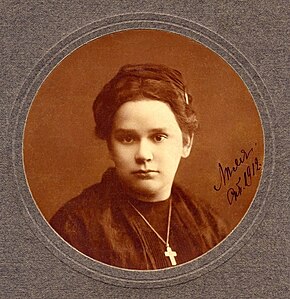Cherubina de Gabriak
 |
|
| Born |
March 31, 1887 St Petersburg |
| Died | December 5, 1928 (aged 41) Tashkent |
Cherubina de Gabriak (Russian: Черуби́на де Габриа́к; IPA: [tɕɪˈrubʲɪnə dʲɪ ɡəbrʲɪˈak]) was a literary pseudonym of Elisaveta Ivanovna Dmitrieva (Russian: Елизаве́та Ива́новна Дми́триева; IPA: [jɪlʲɪzɐˈvʲetə ɪˈvanəvnə ˈdmʲitrʲɪjɪvə]; March 31, 1887 – December 5, 1928), possibly together with Maximilian Voloshin.
In August 1909, the famous Russian artistic periodical Apollon received a letter with verses on a perfumed paper with black mourning edges, signed only by a single Russian letter Ch. The verses were filled with half-revelations about its author—supposedly a beautiful maiden with dark secrets. The same day a woman with a beautiful voice phoned the journal's publisher Sergei Makovsky and arranged for publication of the verses. Over the next few months, publications of the newfound poetic star were the major hit of the magazine, and many believed that they had found a major new talent in Russian poetry. The identity of the author was slowly revealed: her name was Baroness Cherubina de Gabriak, a Russian-speaking girl of French and Polish ancestry who lived in a very strict Roman Catholic aristocratic family, who severely limited the girl's contacts with the outside world because of an unspoken secret in her past. Almost all of Apollon’s male writers fell in love with her, most of all the great poet Nikolai Gumilyov. He wrote a series of passionate love letters to her and received quite passionate answers.
The mystery of the newfound genius was short-lived. In November it was discovered that the verses were written by a disabled schoolteacher, Elisaveta Ivanovna Dmitrieva, with the participation of a major Apollon contributor and editor, the poet Maximilian Voloshin.
...
Wikipedia
